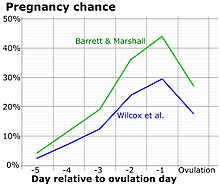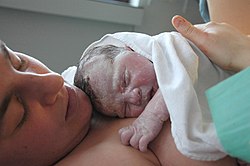Human reproduction
| Part of a series on |
| Sex |
|---|
 |
| Biological terms |
| Sexual reproduction |
|
| Sexuality |
| Sexual system |
Human reproduction is
Biological and legal requirements
In order for human reproduction to be achieved, an individual must have undergone
Legal factors also play a vital role in the achievement of human reproduction: a
Anatomy
Male reproductive system
The male reproductive system contains two main divisions: the testicles where sperm are produced, and the penis which discharges the sperm as semen (this is known as an ejaculation). In humans, both of these organs are outside the abdominal cavity. Having the testicles outside the abdomen facilitates temperature regulation of the sperm, which require specific temperatures to survive about 2-3 °C less than the normal body temperature i.e. 37 °C. In particular, the extraperitoneal location of the testicles may result in a 2-fold reduction in the heat-induced contribution to the spontaneous mutation rate in male germinal tissues compared to tissues at 37 °C.[7] If the testicles remain too close to the body, it is likely that the increase in temperature will harm the spermatozoa formation, making conception more difficult. This is why the testes are carried in an external scrotum rather than within the abdomen; they normally remain slightly cooler than body temperature, facilitating sperm production.
Female reproductive system
The female reproductive system likewise contains two main divisions: the external genitalia (the
The
The ova, which are the female sex cells, are much larger than the spermatozoon and are normally formed within the ovaries of the female fetus before birth. They are mostly fixed in location within the ovary until their transit to the uterus, and contain nutrients for the later zygote and embryo. Over a regular interval known as the menstrual cycle, in response to hormonal signals, a process of oogenesis matures one ovum which is released and sent down the fallopian tube. If not fertilized, this egg is flushed out of the system through menstruation.
Process of fertilization
4. zygote; 5. embryonic development;
6. childbirth; 7. adolescence

Human reproduction normally begins with copulation, though it may be achieved through artificial insemination, and is followed by nine months of pregnancy before childbirth. Pregnancy can be avoided with the use of contraceptives such as condoms and intrauterine devices.[8]
Copulation
Human reproduction naturally takes place as

Alternative methods
As an alternative to natural sexual intercourse, there exists
Pregnancy
Pregnancy is the period of time during which the fetus develops, dividing via mitosis inside the uterus. During this time, the fetus receives all of its nutrition and oxygenated blood from the mother, filtered through the placenta, which is attached to the fetus' abdomen via an umbilical cord. This drain of nutrients can be quite taxing on the mother, who is required to ingest slightly higher levels of calories. In addition, certain vitamins and other nutrients are required in greater quantities than normal, often creating abnormal eating habits. Gestation period is about 266 days in humans. While in the uterus, the baby first endures a very brief zygote stage, then the embryonic stage, which is marked by the development of major organs and lasts for approximately eight weeks, then the fetal stage, which revolves around the development of bone cells while the fetus continues to grow in size.[18] It is estimated that about 3-5% of couples are infertile and the fecunditity of couples is around 30% for each menstrual cycle.[19]
Labor and birth

Labor is separated into 4 stages. The first stage involves latent phase and active phase separated by the dilation of the cervix for 6 to 10 cm. The second stage is the pushing stage. The third stage involves the delivery of the placenta. And the last stage is the contraction of the uterus.[20] Once the fetus is sufficiently developed, chemical signals begin the process of birth, which begins with the fetus being pushed out of the birthing canal. The newborn, which is called an infant in humans, should typically begin respiration on its own shortly after birth. Not long after, the placenta eventually falls off on its own. The person assisting the birth may also sever the umbilical cord.
Discovery of mechanism
While most ancient human societies believed that
were not discovered until the late 1800s.See also
- Heterosexuality
- Antinatalism
- Evolution of sexual reproduction
- Female infertility
- Human Reproduction (journal)
- Journal of Human Reproductive Sciences
- Male infertility
- Natalism
- Paternal age effect
- Reproduction
- Reproductive system
- Legislation on human reproduction
- Reproductive health
References
- ^ ISBN 9780123897701
- ^ a b "Gametogenesis – an overview | ScienceDirect Topics". sciencedirect.com. Retrieved 2022-09-12.
- ^ PMID 26175891.
- ISBN 978-1137505194. Archivedfrom the original on May 9, 2021. Retrieved August 31, 2021.
Voluntary sexual intercourse with a post-pubescent minor who is younger than the legal age of consent is described as statutory rape. [...] In most states, age of consent is delimited between 16 years old and 18 years old. [...] In almost every jurisdiction, prepubescent children may not engage in any sexual contact. [...] Engaging in sexual contact with a prepubescent child is a serious criminal offense and a felony.
- ^ "Statutory Rape Known to Law Enforcement" (PDF). U.S. Department of Justice - Office of Juvenile Justice and Delinquency Prevention. Archived (PDF) from the original on 2007-10-21. Retrieved 2021-08-31.
- PMID 15142897.
- PMID 4797.)
{{cite journal}}: CS1 maint: multiple names: authors list (link - from the original on 2022-08-26. Retrieved 2022-09-12.
- ISSN 1756-2228. Archived from the original on May 13, 2016. Retrieved May 8, 2016.)
{{cite journal}}: CS1 maint: multiple names: authors list (link - ^ "Conception: How It Works". The Regents of The University of California. 2002. Archived from the original on March 15, 2016. Retrieved May 8, 2016.
- ^ "Fertility Basics". Complete Fertility Centre Southampton. Complete Fertility Ltd. 2015. Archived from the original on May 8, 2016. Retrieved May 8, 2016.
- ^ "Conception & Pregnancy: Ovulation, Fertilization, and More". WebMD, LLC. 2016. Archived from the original on May 8, 2016. Retrieved May 8, 2016.
- PMID 10402400.
- ISBN 0-06-093764-5.
- ^ "How to get pregnant". Mayo Clinic. 2016-11-02. Archived from the original on 2020-05-18. Retrieved 2018-02-16.
- ^ "Fertility problems: assessment and treatment, Clinical guideline [CG156]". National Institute for Health and Care Excellence. Archived from the original on 2018-02-17. Retrieved 2018-02-16. Published date: February 2013. Last updated: September 2017
- ^ Dr. Philip B. Imler & David Wilbanks. "The Essential Guide to Getting Pregnant" (PDF). American Pregnancy Association. Archived from the original (PDF) on 2018-06-01. Retrieved 2018-02-16.
- ISBN 978-0-07-803520-3.
- from the original on 2022-06-15. Retrieved 2022-09-12.
- from the original on 2022-06-15. Retrieved 2022-09-12.
Altrui - The Human Egg Cell Explained
Further reading
- Hopwood, Nick, 44 scholarly essays by historians.
- Dolnick, Edward (2017). The Seeds of Life: From Aristotle to da Vinci, from Sharks' Teeth to Frogs' Pants, the Long and Strange Quest to Discover Where Babies Come. Basic Books. ISBN 978-0465082957.
